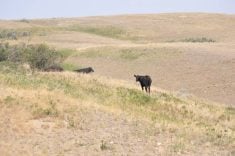Several years ago, combination drugs that combined antibiotics, steroids and antihistamine in one bottle were pulled in the interests of meat safety and beef quality assurance.
Today, with more thought on animal welfare, we often prescribe an anti-inflammatory painkiller with the antimicrobial we are about to use.
Veterinarians try to replace the more traditional use of steroids with non steroidal anti-inflammatory drugs (NSAIDs). Generics are now available, as well as other families of NSAIDs, but flunixin or Banamine was the first on the market.
Resflor is a combination of Banamine and another previously approved antibiotic, florfenicol, marketed under the trade name of Nuflor.
Read Also

Drones now used to assess wildlife crop damage in Saskatchewan
Wildlife damage in Saskatchewan crops is now assessed by drones and artificial intelligence.
As with all prescription drugs, it requires a valid veterinary-client-patient relationship to purchase and use.
The most obvious benefit of any combination product is that fewer needles are given.
In keeping with beef quality assurance, manufacturer Intervet Schering Plough Animal Health has licensed Resflor for subcutaneous use only at the same dosage as Nuflor (six cc per 45 kilograms). Blood levels persist for four days.
While it is as effective as Nuflor, its blood levels are reached quicker and stay higher for the first 24 hours. This is most likely the result of the antiinflammatory effects of the flunixine, which allows the drug to more quickly penetrate the site of infection.
It is primarily approved for respiratory pathogens.
Cattle will appear better as the flunixin decreases the fever, which improves the clinical depression and the animal’s ability to breathe.
This allows time for the antibiotic to start working and decreases the amount of consolidated lung.
Cattle with more consolidation have slower growth. As well, consolidated tissue may abscess, which results in further problems with reoccurrence of pneumonia. The quicker pneumonia is treated, the better because it minimizes the amount of consolidation or scarring and adhesions of the lungs.
Resflor is the first new combination product on the market for several years, which is why the Veterinary Drug Directorate has made the slaughter withdrawal slightly longer than the individual drug Nuflor.
The drug has a withdrawal time of 60 days and can’t be given to veal calves or dairy cattle, milking or dry.
It will primarily be used for respiratory disease on calves or light feeder cattle where the 60 day slaughter withdrawal is easily followed. Products with shorter or no withdrawal are used in heavy feeder cattle.
Approval work for the registration found that Resflor is useful in treating a large number of maladies because the antibiotic penetrates into areas such as skin, muscle, soft tissue in the foot, the brain and areas around the eye.
Producers and their veterinarians must decide for themselves which conditions to treat. More of them will appear on the label over time.
Unlike Banamine, which is given intravenously, Resflor is given subcutaneously with little swelling at the injection site.
The recommended dosage of six cc per 45 kg is a large volume, and I would split that over at least two injection sites in larger calves. The recommendation is no more than 10 cc per site.
The drug is relatively thick, like Nuflor, and must be kept warm in winter. A larger bore 16 gauge needle should be used to overcome the poorer syringability.
The Banamine dosage in Resflor is formulated to be the same as the 24 hour dosage of two cc per 45 kg if given individually. This means the Banamine in Resflor will last better than 24 hours, which is often all that is needed.
It is cheaper than the combination of the two products and I believe over time Resflor sales will mostly replace Nuflor. It has all the benefits that producers have received from Nuflor with the added benefits that come from a NSAID.
It is a welcome addition to today’s arsenal developed primarily for bovine respiratory disease.














